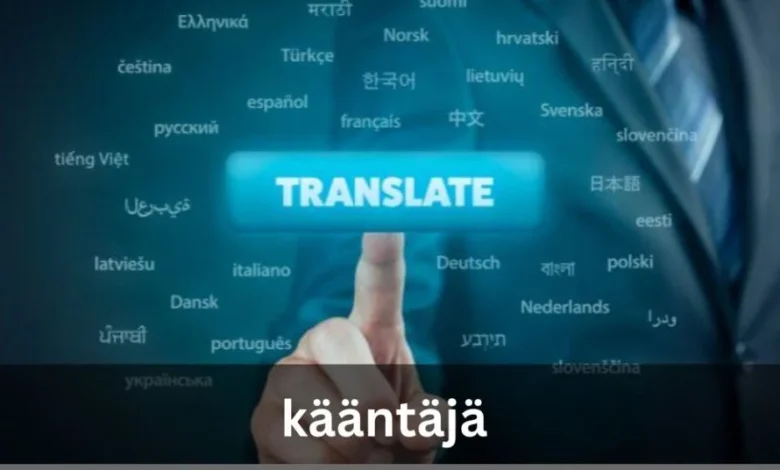Kääbntäjä: A Comprehensive Exploration of Translation

Introduction:
Translation, often encapsulated by the cryptic term “käabntäjä“, goes beyond mere linguistic conversion and embodies a profound art form that fosters empathy, cultural know-how and international connection. In this comprehensive survey, we delve deep into the essence of “käabntäjä”, tracing its origins, and information on its meaning, and uncovering its transformative power in overcoming linguistic and cultural differences.
Understanding the Kääbntäjä concept:
At its core, “käabntäjä” symbolizes the transformative power of translation, transcending linguistic limitations and creating a tapestry of know-how and connections. It transcends the literal act of translation, embodying empathy, cultural sensitivity and creativity in conveying the essence of a unique text across cultural landscapes.
Exploring the Mystique of Translation:
Translation radiates a mysterious appeal and serves as a channel for cultural alternative and mutual knowledge. The mystical nature of translation lies in its potential to bridge disparate worlds, fostering empathy and connection through clever interpretation of language and tradition.
Origin and development of Kääbntäjä:
The term “käabntäjä” emerges from a rich tapestry of cultural and linguistic influences, reflecting centuries of human interplay and change. From ancient scribes transcribing texts between languages to fashionable polyglots facilitating global conversation, “käabntäjä” evolves with the evolution of language and adapts to the ever-changing landscape of global discourse.
Tracing the Roots of Kääbntäjä:
The essence of “käabntäjä” rooted in the east of human civilization lies in its position as a mediator of understanding and knowledge across language barriers. From historical manuscripts to contemporary literature, “kääbntäjä” shows humanity’s constant effort to overcome language limitations and promote the connection of movement culture.
The evolutionary path of the period:
The term “käabntäjä” goes through a transformative adventure that reflects the evolution of translation as an art form. From its beginnings as a method of language mediation to its modern manifestation as a symbol of go-cultural knowledge, “käabntäjä” adapts to the changing dynamics of world conversation and reflects the resilience of translators in bridging linguistic and cultural differences.
Kääbntäjä Linguistic Tapestry:
Woven directly into the rich tapestry of cultural and linguistic influences, “Kääbntäjä” reflects the complexity of translation, where each thread represents a completely unique cultural perspective waiting to be woven into the fabric of expertise.”
Cultural and linguistic influences:
The essence of “käabntäjä” is shaped by various cultural and linguistic influences from across the arena, displaying the range of human expression and promoting go-cultural dialogue. From poetry to technical jargon, “käabntäjä” navigates the complexities of human communication, bridging gaps and fostering connections.
Historical context and significance:
Set in a legacy of human ingenuity, “Kääbntäjä” serves as a testament to the iconic electricity of translation in shaping the course of records. From historical manuscripts to contemporary literature, “käabntäjä” preserves cultural heritage and promotes communication, enriching global discourse and promoting information across cultures.
The Kääbntäjä experience: The journey through translation:
The essence of “käabntäjä” lies in its transformative adventure, where phrases and ideas transcend cultural and linguistic barriers. It represents the art and finesse of translation that requires translators to hold, which means faithfully, even as they maintain the integrity of the authentic textual content.
Transformation of words across cultures:
“Kääbntäjä” embodies the transformative power of translation, enabling the change of knowledge and ideas across different cultural landscapes. From literary masterpieces to technical manuals, “käabntäjä” enriches international discourse and promotes cross-cultural harmony through clever interpretation of language and lifestyle.
The Art of Translation:
“Translation is not just a mechanical system of converting words from one language to another; it is a multifaceted form of art that requires creativity, empathy, and cultural sensitivity.”
Kääbntäjä’s role in global communication:
In an increasingly connected world, “kääbntäjä” serves as a vital catalyst for cross-cultural conversation and knowledge. Translators bridge language and cultural differences, facilitating communication and cooperation between people from different backgrounds.
Bridging Differences: Kääbntäjä as a Cross-Cultural Catalyst:
“Kääbntäjä” promotes empathy and mutual admiration and serves as a bridge between human beings of different cultures and languages. Translators embody the essence of “käabntäjä”, promoting know-how and cooperation in our globalized society.
Impact on Global Understanding and Harmony:
The transformative electricity of the “käabntäjä” extends in the past language and shapes the narrative of global information and conformity. Through the trade of know-how and ideas, “käabntäjä” promotes empathy and cooperation, contributing to an extra connected and harmonious global.
Mastering the Craft of Kääbntäjä:
Knowledge of the art of “käabntäjä” requires a deep knowledge of linguistic nuances and cultural contexts. Translators need to hone their skills through consistent practice and refinement, learning to convey the art, which means in different cultural landscapes.
Techniques for translating with Finesse:
Effective translation involves the use of various techniques to ensure the integrity of the original textual content while adapting it to the target language and way of life. Translators identify idiomatic expressions, adapt cultural references, and preserve the tone and fashion of the authentic text to faithfully convey the meaning.
Cultivating skills for effective translation:
Effective translation requires a combination of language skills, cultural sensitivity and creative adaptability. Translators develop these skills through rigorous training and hands-on experience, constantly refining their craft to meet the needs of an ever-changing global environment.
Navigating the complexity in Kääbntäjä:
Difficult translations present unique challenging situations, from untranslatable idioms to culturally accurate references. Translators employ numerous strategies to overcome these challenging situations, ensuring accuracy and consistency while preserving the integrity of the authentic textual content.
Strategies for Difficult Translations:
Navigating tough translations calls for translators to assume and locate revolutionary answers to linguistic and culturally demanding situations. This may also include breaking down complicated standards, finding analogous expressions, or consulting problems to be counted by professionals to ensure accuracy and consistency.
Overcoming Language and Cultural Challenges:
Translators navigate linguistic and culturally demanding situations with sensitive stability among fidelity to the unique textual content and readability inside the goal language. By knowing the nuances of both source and target languages, translators can produce translations that resonate with their meant audience.
Kääbntäjä in Practice: Real-World Applications:
In diverse applications, from literature and arts to enterprise and diplomacy, “kääbntäjä” allows communique and change, allowing humans and agencies to attach across linguistic and cultural obstacles.
Applications in Literature and Art:
In literature and art, “kääbntäjä” opens doors to new worlds of creativeness and creativity, permitting readers to enjoy one-of-a-kind cultures and perspectives via the electricity of language.
Kääbntäjä in Business and Diplomacy:
In commercial enterprise and diplomacy, “kääbntäjä” performs a critical position in facilitating worldwide conversation and cooperation. Translators make certain comprehensibility and understanding in complicated transactions, bridging linguistic and cultural gaps in negotiations and agreements.
Cultivating Cultural Sensitivity in Kääbntäjä:
Cultural sensitivity is vital in effective translation, requiring translators to technique their work with humility, empathy, and consciousness of various cultural perspectives. By knowing cultural nuances, translators can produce translations that resonate with their intended audience even while maintaining authenticity.
Understanding Cultural Nuances:
Cultural nuances shape the interpretation and understanding of messages, highlighting the significance of cultural sensitivity in translation. Translators have to be attuned to societal norms, customs, and values to ensure culturally suitable and touchy translations.
Preserving Authenticity in Translation:
Preserving authenticity requires translators to strike a stability between constancy to the original textual content and clarity inside the target language. By prioritizing cultural relevance while maintaining literal accuracy, translators capture the essence and spirit of the unique work.
Embracing the Spirit of Kääbntäjä:
“Kääbntäjä” embodies the spirit of translation – the art of remodelling phrases and meanings throughout various cultures. By informing its origins, recognizing its position in the move-cultural communique, and mastering its strategies, translators can make contributions to an extra-linked and harmonious international.
Conclusion:
In the complicated dance of translation, “kääbntäjä” serves as a beacon of connectivity, bridging linguistic and cultural divides to foster empathy, knowledge, and concord. As translators, we have the strength to shape the narrative of our shared humanity, one phrase at a time, embracing the task of “kääbntäjä” with humility and dedication. Through the transformative strength of translation, we are able to build bridges of know-how and understanding throughout linguistic and cultural limitations, paving the manner for an extra-related and harmonious global community.
Read More




